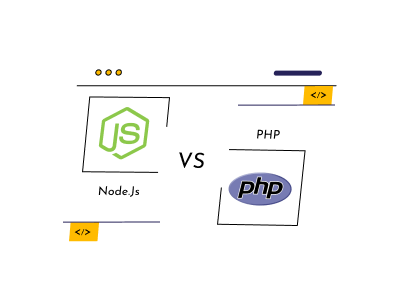Deciding on a language for server-side programming requires business owners and development teams to review many programming languages, analyze their benefits, and align them with project needs. New languages emerge all the time, and Node.js and PHP are among them and have emerged as rivals. And similar to other web development technologies, there’s an ongoing debate among developers about which one among Nodejs vs PHP is the best.
Rasmus Lerdorf in the year 1994 developed PHP, which is an abbreviation for Hypertext Preprocessor and an open-source general-purpose server-side scripting language. It is used for website development by lots of websites and applications.
Whereas, Node.js is an open-source server-side JavaScript runtime environment that enables website developers to execute JavaScript on the server side, and it is also ideal for developing faster, highly scalable, and effective back-end solutions.
As both of them are separate tools, they still work on the same technology platforms and offer the same capabilities. Because of this, it isn’t easy to understand the difference between Node.js and PHP and decide between these two options.
In this blog, we’ll walk you through these server-side technologies, understand what exactly PHP and Node.js are and their applications, and come up with their pros and cons along with their distinct features.
Hosting Nodejs website or app? MilesWeb offers you Nodejs Hosting at best price!
Table of Content
Statistics on Node.js and PHP
To understand how widely both languages are used, let’s take a look at tangible numbers and examine what kind of websites are currently using PHP and Node.js technologies.
– PHP statistics
The language is used by around 76.5% to 77% of websites around the world, which makes it the most common server-side language right now. 4 out of 5 websites that you’ve visited today are likely to use PHP. Today, PHP is one of the oldest backend languages in use, which explains its popularity. We’ll take a closer look at technical characteristics that brought PHP to its rise.
– Node.js statistics
Node.js is used by around 1.4% to 2.2% of websites around the world, but its position is getting stronger, whereas PHP is losing traction. Even though Node.js still falls short of PHP in terms of usage statistics, it has a positive momentum – the language will likely keep gaining traction.
Node.js Overview
Node.js is an open-source runtime environment, based on V8 JavaScript. Many developers initially make a mistake of thinking of it as a library or framework for JS, but in reality, it’s an independent environment.
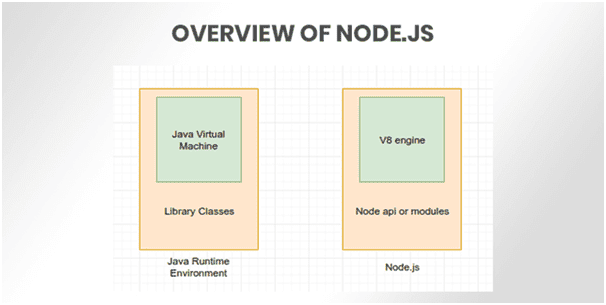
Image source: Hackernoon
Node.js is one of the newest web development tools out there – it was introduced in 2009 and was quickly praised as one of the most promising JS-based solutions. The company that developed Node.js previously participated in Ruby on Rails development and provided hosting for Twitter and LinkedIn. Right away, the runtime environment had a strong experienced technical team that was looking to develop a modern web development solution.
Although the solution quickly caught the interest of tech enthusiasts, developers, and businesses, the interest peaked in 2017, according to Google Trends. Now any code editor supports Node.js along with JavaScript, and it’s compatible with multiple CMSs.
| PHP | Node.js | |
| Release Date | 08.06.1995 | 27.5.2009 |
| Packages Repository | Composer | NPM |
| Have LTS? | Yes | Yes |
| License (for commercial use) | PHP License | MIT License |
| Frameworks | 40 PHP Frameworks | 3 Node.js Frameworks |
| Websites | Around 76.7% | 6.3 million |
| Companies | HCL, Infosys, TCS, Wipro, Accenture, and Cognizant | Amazon, LinkedIn, Tumblr, Netflix, and PayPal |
PHP Overview
After examining the usage of both languages, Node.js and PHP, we need to take a look at their history and purpose to know how they reached their current level. Let’s start by defining PHP, the most popular server-side language up to date.
PHP is one of the first software development languages that was created precisely for web development. The language was developed in 1994 under its original name of Personal Home Page, which was later changed to Hypertext Processor.
Reasons for PHP’s Popularity
The language popularity is partially explained by the fact that it’s used by Zend Engine – an engine that powers Nginx and Apache. This makes PHP code highly compatible with HTML, which is why it’s a must-know for any web developer.
Another crucial factor is the connection between PHP and WordPress. One of the most popular content management systems, used by 34% of all websites, is written in PHP. This means, if a website is using WordPress, it will likely use PHP. It’s possible to combine it with another language, but still, PHP provides the core functionality.
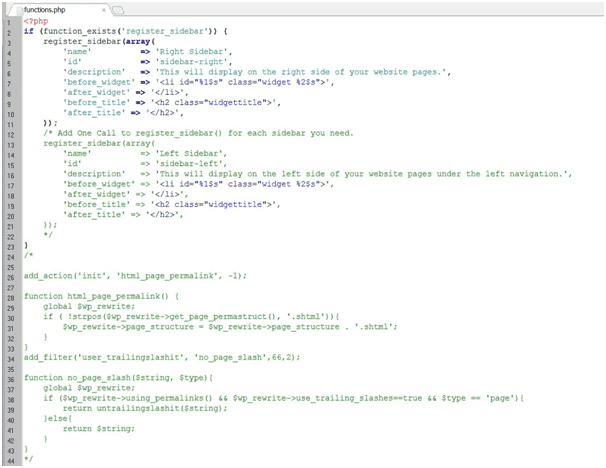
Image source: Wikimedia
A lot of companies and web platforms use PHP to write backend software and admin panels for their websites. One of the most prominent examples is Wikipedia: the software behind the platform, MediaWiki, uses PHP for its backend functionality. Also, Joomla and Drupal use PHP quite extensively – although not quite as much as WordPress.
It’s possible to say that web development, the way we know it today, is deeply rooted in PHP. Content management systems, additional software, and frameworks have been around for decades, and knowing PHP has become a must for any web developer.
Comparison Node.js vs PHP Benchmark
Let’s take a deeper look at the key technical characteristics of Node.js and PHP technologies side by side before we move to evaluate their benefits and drawbacks individually. Because languages were developed a decade apart, they have a lot of differences in their design and syntax, although, with recent updates, these differences become less drastic. Both Node.js vs. PHP languages are perfectly suited for current development standards, but still, there are structural differences.
1. Node.js vs. PHP Simplicity
When we consider Node vs. PHP simplicity, PHP takes less time to learn and is easier to set up—it doesn’t require a powerful interface and is well-equipped to run on old hardware. The language doesn’t require converters and compilers. You can connect it directly to the SQL database, and there is no need to adapt to specific hosting standards.
Node.js, however, is more complicated. The deployment of the environment requires powerful server infrastructure and additional frameworks. Some developers consider the syntax of the language itself easier than of PHP, but the preparation is certainly more complex.
2. Node.js vs. PHP Database
PHP supports MySQL, PostgreSQL, and MariaDB. The code can be integrated with almost any database solution. Almost all existing web development solutions were adapted to fit PHP because it’s used so widely.
Node.js, despite being not that popular, also offers multiple database integrations. It supports MySQL and uses JSON for database integration. Even though PHP can be also technically connected to JSON, Node.js offers higher compatibility.
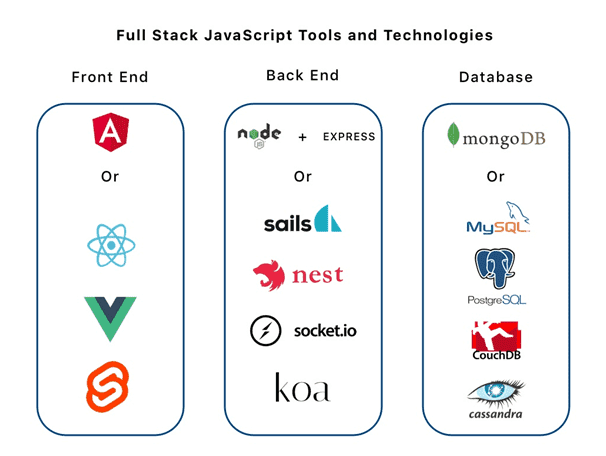
3. Node.js vs. PHP Hosting
Due to its popularity, PHP has significantly more web hosting services than Node.js. The deployment of PHP is faster and easier, plus, it doesn’t require a virtual server with an SSH connection. To deploy a Node.js project, you need to create a complex virtual server infrastructure.
4. Node.js vs. PHP Performance
When we consider PHP vs. Node.js performance, PHP is stable in its performance, but it works slower than Node.js. The explanation for this is simple: Node.js uses a V8 engine which is known to be one of the fastest right now, callback functions that allow working with multiple requests simultaneously.
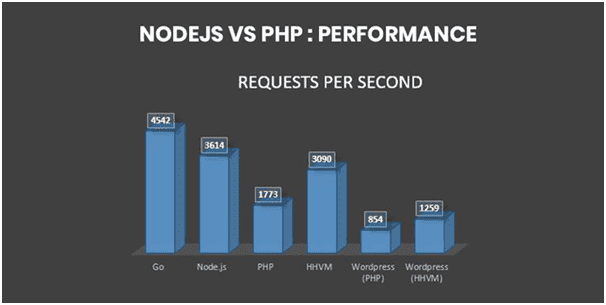
Image source: Hackernoon
5. Updates
Even though PHP is one of the oldest languages for web development, it’s regularly updated to fit web standards and provide higher performance speed. That said, the core architecture of the language is still old-fashioned, and to catch up to younger languages, PHP would need a complex upgrade.
Node.js, on the other hand, is much more advanced in this regard. From its first release, the language used powerful engines and modern architecture, and it was developed to suit modern development requirements. The code can be easily cleaned up and edited, it’s easier to track and write due to a new syntax.
6. Node.js vs. PHP Modules
PHP uses module installing technologies such as PEAR (PHP Extension and Application Repository) and Composer.
- PEAR (PHP Extension and Application Repository): It is a framework and distribution system for reusable PHP components. It was developed to promote a well-structured code library and a standard coding style, maintain a distribution and maintenance system of code packages.
With PEAR, the developers had a repository of components that would provide solutions for a variety of areas such as encryption, databases, web services, etc. And every component can be used individually, without the need of using a huge framework for very particular solutions. - Composer: It is a simple and reliable tool for dependency management in PHP used to declare and manage the project-dependent libraries, manage and integrate external packages into the PHP-based projects.
Not only does the Composer help developers to resolve dependencies on a per-project basis, but also they can control packages for each project and keep the project size in check.
Node.js comes prepackaged with the NPM package management system and its registry.
- NPM: It consists of a command line client called npm and manages all the packages and modules for Node.js. The required packages and modules in the Node-based projects are installed using NPM that gets installed into the system with the installation of Node.js. All the files required for a module and modules are the JavaScript libraries that are contained in a package and can be included in the Node-based projects according to the requirement.
To sum up, NPM is easy to use and publish than the PHP modules. In addition to that, PHP doesn’t come bundled with modules. That’s why developers need to download and install them manually.
7. Node.js vs. PHP Web Server Setup
Node.js comes prepackaged with core modules that include the file system, HTTP, and DNS. That significantly helps in developing customized web servers. Express.js, Koa.js, and Sails.js technologies are some of the most popular Node.js frameworks that can be set up using 4 lines of code at maximum to empower Node.js running web servers.
PHP versions prior to v5.4 required downloading and setting up XAMPP and LAMP servers. What’s more, PHP comes bundled with an inbuilt development server.
Advantages of Node.js
Node.js is gaining traction quickly, even despite not being the most popular backend technology yet. The environment offers many decisive benefits that make up for the fact that it’s not yet widely used.
– It’s Easy to Learn
Node.js is based on JavaScript which is one of the most popular and used programming languages right now. For a developer who already knows JS, it’s easy to learn the main principles of Node.js and adapt them to the backend.
– Fast Performance
Node.js performance is much faster than that of JavaScript. The environment can easily process concurrent events, whereas PHP doesn’t provide the same opportunity. This makes Node.js a perfect fit for big web platforms, making it easy for developers to introduce new functionality and scale.
– Flexibility
Node.js has very few dependencies and additional rules. Programmers can work with various patterns, modules, etc. Developers can download helpful modules and introduce new tools to their workflow, and Node.js adapts well to these integrations. Also, because it’s based on JavaScript, it’s compatible with almost all solutions in the JS ecosystem.
Disadvantages of Node.js
- The technology isn’t the most popular backend solution yet. It will take time for the environment to get a large dedicated community.
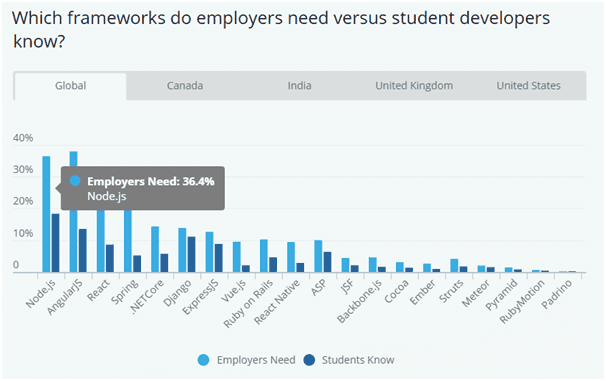
Image source: HackerRank
- It’s complex to set up. Node.js requires additional connections and integrations, whereas PHP can be deployed directly.
- It’s not the best option for CPU-intensive activities. If an app requires generating or editing media files or doing live streams, Node.js will not deliver its optimal performance in such graphic-centric processes.
Advantages of PHP
PHP has become the most popular backend language for a reason. Even though many developers think that its reputation of the oldest web development language creates more problems than benefits, it’s unreasonable to deny the obvious strengths of the language.
– Easy Maintenance
PHP uses the MVC architecture that structures the code in the application and helps to navigate through millions of lines by breaking the file down into manageable sections. Each model is stored and displayed separately which makes it easy to locate and edit a particular piece of code.
– Stable Performance
PHP is a definition of slowly-but-surely in web development. Even though the environment obviously uses to Node.js in terms of speed, it shows a more consistent performance when it comes to CPU-demanding tasks and graphics-centered operations.
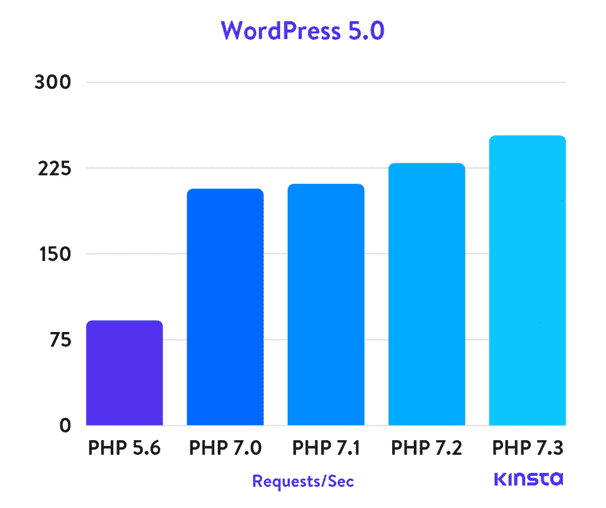
Image source: Kinsta
– Popularity
Finding a professional development team that knows PHP is easy because the language is very popular and it has been around for a long while. There are a lot of tools and guides for PHP’s adoption.
Disadvantages of PHP
- PHP is not a scalable solution. The PHP is combined directly with the language syntax, which means, you will be changing both code in the language and HTML code. JavaScript frameworks and environments are more isolated and a change in the code doesn’t affect the entire functionality quite as much.
- PHP doesn’t handle many processes simultaneously. Instead of having each module is responsible for a single operation, the entire codebase will participate in executing operations. If you have many operations, the performance quality will obviously drop.
Both Node.js and PHP solutions have their strengths and weaknesses, and because of different technical characteristics, distinct use cases emerged for both. Let’s take a look at applications for Node.js and PHP:
Where to use Node.js?
1. Dynamic single-page applications: They are using JavaScript to process user requests, and Node.js for backend is a logical option.
2. JavaScript frontend technology: If you want to work with Angular, React, or JQuery for frontend, it makes sense to pick Node.js for backend solution, because they will be easy to integrate and support.
3. Real-time development: If you want to build scalable apps where fast performance is the key criterion, Node.js is likely your top choice.
Where to use PHP?
1. A website that uses content management systems (WordPress, Drupal, Joomla).
2. A solution that uses the LAMP stack (MySQL, Apache, etc).
3. Projects where you need to find a competent team quickly and be sure that you will have professionals who can maintain the ready solution. It’s easy to find a competent PHP partner because it’s a must-have skill for any web developer.
PHP and Node.js appeal to developers, businesses, and end-users as server-side frameworks due to their universality. Both solutions can be connected to major tech stacks and adapted to scalable solutions. The major difference between Node.js and PHP is the performance speed, where Node.js wins, and popularity, where PHP is definitely the leader. Businesses and development teams need to decide if scalability and speed are more important than universality and high compatibility. We’ve outlined used cases that highlight the purpose of both solutions best.
FAQs
1. What is the difference between Node.js and PHP?
Node.js is an open-source cross-platform server-side JavaScript runtime environment, whereas PHP is an open-source general-purpose server-side scripting language.
2. Which are the best use cases for Node.js and PHP?
Node.js can be useful for dynamic single-page applications, JavaScript frameworks, and real-time development. On the other hand, PHP can be useful for websites that use CMS platforms like WordPress, Drupal, and Joomla. Different solutions that use the LAMP stack, i.e., MySQL, Apache.
3. How are asynchronous operations managed by Node.js?
In order to handle asynchronous operations, Node.js makes use of Callback functions.
Are Node.js and PHP replacable?
Node.js is a PHP alternative but both are not interchangeable.
Which is easier to learn for beginners between Node.js and PHP?
PHP is widely regarded as the easiest to learn for beginners due to its simple syntax, higher compatibility with web hosting providers, and a big developer community to help you.
